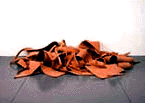In the 1960s, several artists in Europe and the United States rejected both the traditional conventions of painting and sculpture and the impersonal character of Minimalist and Conceptual art. In their works, these artists used such non-art materials as feathers, rubber hosing, neon, lettuce, and felt. To manipulate these mediums, they combined them with other materials and objects, placed them in unusual arrangements, or broke them into pieces. In general, their work emphasizes the temporality, rather than the presumed permanence, of the art object and draws attention to the process of its construction more than the final result, which can sometimes change according to installation or the effects of time.
This 1960s phenomenon of using nontraditional materials in art practice was international in scope. The term Arte Povera, (which means literally “poor art”) refers to this type of art made in Italy, including the work of Giovanni Anselmo, Jannis Kounellis, Mario Merz, Pino Pascali, and Gilberto Zorio. The Musée national d'art moderne has acquired their work extensively.
 Joseph Beuys Homogen infiltration for Grand Piano (Infiltration homogen für Konzertflügel) 1966 Centre Georges Pompidou, Musée national d'art moderne |
The label Process Art applies to this kind of art outside Italy, in western Europe primarily to the work of German artist Joseph Beuys, and in the United States to the art of, among others, Eva Hesse, Bruce Nauman, and Richard Serra. |
